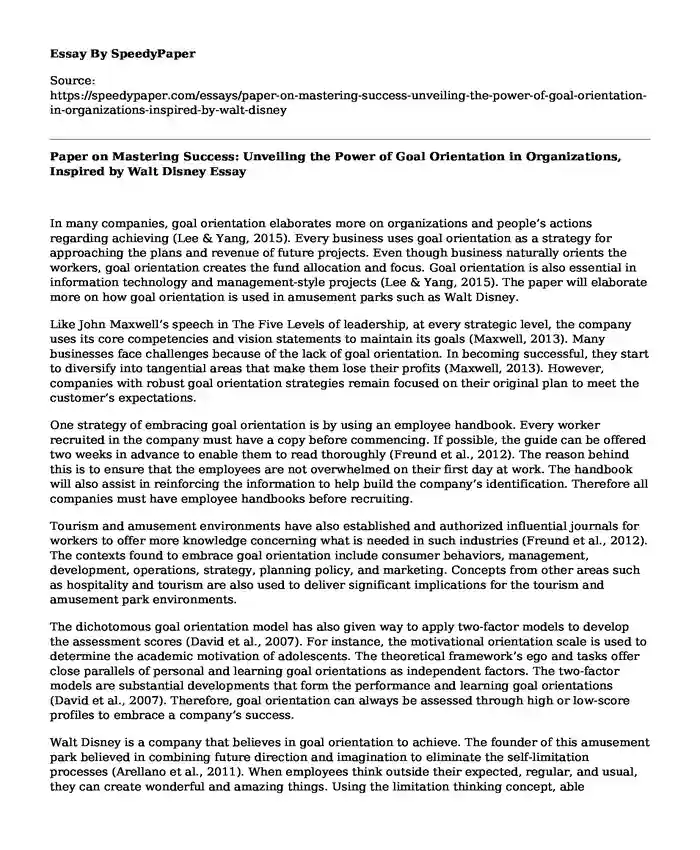In many companies, goal orientation elaborates more on organizations and people’s actions regarding achieving (Lee & Yang, 2015). Every business uses goal orientation as a strategy for approaching the plans and revenue of future projects. Even though business naturally orients the workers, goal orientation creates the fund allocation and focus. Goal orientation is also essential in information technology and management-style projects (Lee & Yang, 2015). The paper will elaborate more on how goal orientation is used in amusement parks such as Walt Disney.
Like John Maxwell’s speech in The Five Levels of leadership, at every strategic level, the company uses its core competencies and vision statements to maintain its goals (Maxwell, 2013). Many businesses face challenges because of the lack of goal orientation. In becoming successful, they start to diversify into tangential areas that make them lose their profits (Maxwell, 2013). However, companies with robust goal orientation strategies remain focused on their original plan to meet the customer’s expectations.
One strategy of embracing goal orientation is by using an employee handbook. Every worker recruited in the company must have a copy before commencing. If possible, the guide can be offered two weeks in advance to enable them to read thoroughly (Freund et al., 2012). The reason behind this is to ensure that the employees are not overwhelmed on their first day at work. The handbook will also assist in reinforcing the information to help build the company’s identification. Therefore all companies must have employee handbooks before recruiting.
Tourism and amusement environments have also established and authorized influential journals for workers to offer more knowledge concerning what is needed in such industries (Freund et al., 2012). The contexts found to embrace goal orientation include consumer behaviors, management, development, operations, strategy, planning policy, and marketing. Concepts from other areas such as hospitality and tourism are also used to deliver significant implications for the tourism and amusement park environments.
The dichotomous goal orientation model has also given way to apply two-factor models to develop the assessment scores (David et al., 2007). For instance, the motivational orientation scale is used to determine the academic motivation of adolescents. The theoretical framework’s ego and tasks offer close parallels of personal and learning goal orientations as independent factors. The two-factor models are substantial developments that form the performance and learning goal orientations (David et al., 2007). Therefore, goal orientation can always be assessed through high or low-score profiles to embrace a company’s success.
Walt Disney is a company that believes in goal orientation to achieve. The founder of this amusement park believed in combining future direction and imagination to eliminate the self-limitation processes (Arellano et al., 2011). When employees think outside their expected, regular, and usual, they can create wonderful and amazing things. Using the limitation thinking concept, able employees who have talents achieve their hearts’ goals and desires.
Conclusion
Goal orientation elaborated more on organizations and people’s actions regarding achieving Walt and strived in quality in everything created in the amusement park. Walt believed that quality offers the best, and a tremendous amount of money is needed to make things right. Even though business naturally orients the workers, goal orientation creates the fund allocation and focus. Walt believed that tension and stress always create achievable goals, but the process needs to be lightened and fun.
References
Arellano, F., Felder, M., Watt, M., & O’Rourke, J. S. (2011). The Walt Disney Company: Disney’s California adventure. https://doi.org/10.4135/9781526403896
David J. Radosevich, Mark R. Allyn, & Seokhwa Yun. (, 2007). Goal orientation and goal setting: Predicting performance by integrating four-factor goal orientation theory with goal-setting processes. Seoul Journal of Business, 13(1), 21-48. https://doi.org/10.35152/snusjb.2007.13.1.002
Freund, A. M., Hennecke, M., & Mustafic, M. (2012). On gains and losses, means and ends: Goal orientation and goal focus across adulthood. The Oxford Handbook of Human Motivation, 279-300. https://doi.org/10.1093/oxfordhb/9780195399820.013.0016
Lee, H., & Yang, T. (2015). Employee goal orientation, work unit goal orientation, and employee creativity. Creativity and Innovation Management, 24(4), 659-674. https://doi.org/10.1111/caim.12118
Maxwell, J. (2013, November 22). The 5 Levels of Leadership. YouTube. https://www.youtube.com/watch?v=4KqL_1G8JD8
Cite this page
Paper on Mastering Success: Unveiling the Power of Goal Orientation in Organizations, Inspired by Walt Disney. (2023, Dec 27). Retrieved from https://speedypaper.com/essays/paper-on-mastering-success-unveiling-the-power-of-goal-orientation-in-organizations-inspired-by-walt-disney
Request Removal
If you are the original author of this essay and no longer wish to have it published on the SpeedyPaper website, please click below to request its removal:
- Investment Essay Sample: Risk and Returns Analysis
- Free Essay Sample on Termination of Contracts
- Pepsi Co. History, Free Essay about the Company
- Essay Example on the Failure of Yahoo China
- Essay Sample on Franchise Opportunity in the Hospitality Sector
- Essay Sampel on Toyota Land Cruiser: From Military Prototype to Heavy-Duty Workhorse
- Theories and Concepts of an AD - Essay Sample
Popular categories





